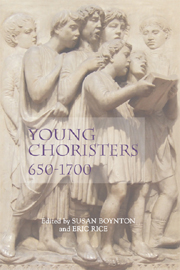Book contents
- Frontmatter
- Contents
- List of Illustrations
- List of Musical Examples
- Acknowledgements
- Dedication
- Introduction: Performance and Premodern Childhood
- 1 The Boy Singers of the Roman Schola Cantorum
- 2 Boy Singers in Medieval Monasteries and Cathedrals
- 3 The Musical Education of Young Girls in Medieval English Nunneries
- 4 Choirboys in Early English Religious Drama
- 5 From Mozos de coro towards Seises: Boys in the Musical Life of Seville Cathedral in the Fifteenth and Sixteenth Centuries
- 6 The Seeds of Medieval Music: Choirboys and Musical Training in a Late-Medieval Maîtrise
- 7 Choirboys in Cambrai in the Fifteenth Century
- 8 Choirboys and Vicaires at the Maîtrise of Cambrai: A Socio-anthropological Study (1550–1670)
- 9 Choirboys, Memorial Endowments and Education at Aachen's Marienkirche
- 10 Thomas Mulliner: An Apprentice of John Heywood?
- 11 Cantando tutte insieme: Training Girl Singers in Early Modern Sienese Convents
- 12 Choirboys in Early Modern Rome
- General Bibliography
- Index
5 - From Mozos de coro towards Seises: Boys in the Musical Life of Seville Cathedral in the Fifteenth and Sixteenth Centuries
Published online by Cambridge University Press: 12 September 2012
- Frontmatter
- Contents
- List of Illustrations
- List of Musical Examples
- Acknowledgements
- Dedication
- Introduction: Performance and Premodern Childhood
- 1 The Boy Singers of the Roman Schola Cantorum
- 2 Boy Singers in Medieval Monasteries and Cathedrals
- 3 The Musical Education of Young Girls in Medieval English Nunneries
- 4 Choirboys in Early English Religious Drama
- 5 From Mozos de coro towards Seises: Boys in the Musical Life of Seville Cathedral in the Fifteenth and Sixteenth Centuries
- 6 The Seeds of Medieval Music: Choirboys and Musical Training in a Late-Medieval Maîtrise
- 7 Choirboys in Cambrai in the Fifteenth Century
- 8 Choirboys and Vicaires at the Maîtrise of Cambrai: A Socio-anthropological Study (1550–1670)
- 9 Choirboys, Memorial Endowments and Education at Aachen's Marienkirche
- 10 Thomas Mulliner: An Apprentice of John Heywood?
- 11 Cantando tutte insieme: Training Girl Singers in Early Modern Sienese Convents
- 12 Choirboys in Early Modern Rome
- General Bibliography
- Index
Summary
THE involvement of a group of boys in the daily rituals of the cathedral of Seville goes back to the restoration of its diocese, whose cathedral was dedicated on 11 March 1252. My aim in this essay is to synthesize the various ways in which this important and indispensable group formed part of the daily life of the cathedral and to incorporate a new perspective based on recent studies of the archival sources. The statutes promulgated on 29 May 1261 by Archbishop Remondo and his chapter already provide evidence for the existence of such a group in the designation alumni cori, who along with the clerici cori were under the jurisdiction of the cantor and the supervision of his vicar or succentor, who assisted him in his duties. The financial support for the maintenance of the choirboys derived from the income willed to the cathedral by King Fernando III, conqueror of the city, and by his son Alfonso X, who left income proceeding from the tithes of his almojarifazgo (1252).
It has not been possible to determine the origin of the position of the magister puerorum in the cathedral of Seville. The office existed as a salaried post by at least the beginning of the fifteenth century and is documented as being held in 1419 by Alfonso Sánchez, the cathedral's first known choirmaster. The definitive impetus for establishing a master of the choirboys would come from Pope Eugenius IV in the course of the reforms he promoted during the 1430s.
- Type
- Chapter
- Information
- Young Choristers, 650–1700 , pp. 86 - 103Publisher: Boydell & BrewerPrint publication year: 2008

